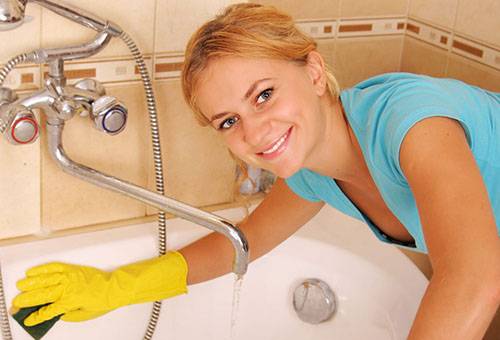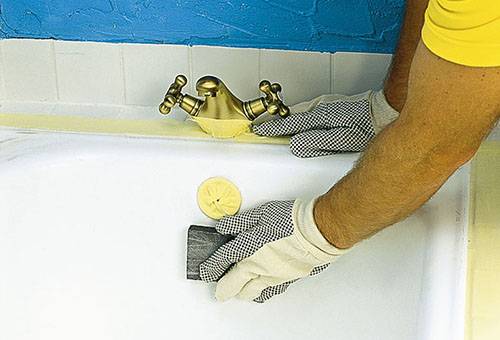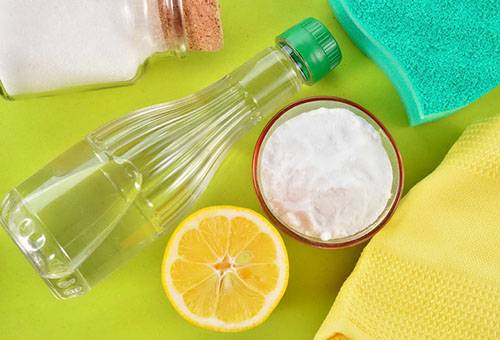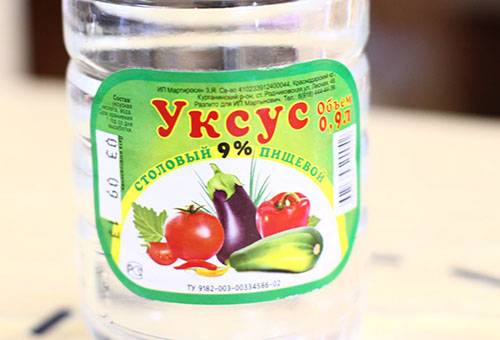How to remove limescale on the surface of the bath?
The stiffness of tap water often creates a number of difficulties for housewives, including annoying limescale deposits in the bathroom and on other surfaces in contact with water. It is formed gradually as a result of the subsidence of insoluble compounds of calcium and magnesium contained in water, and it is difficult to wash it. As a result, the snow-white glossy surface of the plumbing fixture is covered with a layer of beige material, due to which it becomes dull and difficult to clean. And the presence of rust in the water supply can further exacerbate the problem, completely spoiling the appearance of the product with reddish smudges. There are various methods of dealing with such types of pollution. But which one is better to use in your case to clean the surface will depend on a number of individual factors that should be considered when choosing.
What to look for when choosing a factory-made bath cleaner?
Without a doubt, among the many advertised household chemicals, you can find a suitable tool that can clean the bath from mineral deposits. But you should be extremely careful when making a choice, since some substances can not only remove plaque, but also damage the facing of the product. To avoid such a mistake, it is necessary, when choosing a cleaning agent, to take into account the type of material that your bathtub consists of.
These plumbing fixtures can be made from the following materials:
- enamel cast iron;
- enameled steel;
- durable plastic;
- acrylic;
If you have an enamel bath, it is important that the cleaning agent contains anti-corrosion inhibitors. Thanks to them, the chemical effect will be carried out only on calcined plaque, without damaging the enamel, which allows you to safely clean the plumbing. But such a tool is usually quite expensive. Cheap formulations, although they can remove plaque, but after several such procedures, the facing layer will also be spoiled. In addition, it is worth avoiding mixtures that contain sulfuric or nitric acid. Such substances can be used for enameled baths only if they are very dirty and only once.
In order to clean the enamel coating, it is better to use the appropriate product in powder form and act in accordance with the instructions. And there it is usually advised to apply a cleaning agent to a hard sponge and rub it with contaminated places. After that, most likely, the manufacturer will recommend to wait a while and rinse the surface with water. If the layer of mineral deposits is quite thick, then the procedure must be repeated several times to completely clean the product.
Tip
In no case do not use metal washcloths, brushes and other similar objects, trying to quickly remove plaque from the surface of the enameled bath, as the enamel must be spoiled.
For a plastic and acrylic bath, gel-like compositions are more suitable, which are simply applied to problem areas and wait until the chemically active substances entering it convert lime deposits into soluble compounds. The resulting substances can easily be removed from the surface of the bath. Because of their abrasiveness, powder mixtures should not be used for cleaning plastic and acrylic products, since scratches remain on the surface. In addition, to wash acrylic, do not use a product that contains bleach, ammonia, or acetone that can interact with it.Acetone is also dangerous for plastic baths, as it can dissolve polymers.
How to wash limescale in the bathroom without the use of factory products?
Given the fact that when using factory-made cleaning mixtures, it is possible to spoil the product, some housewives decide to use a tool at hand to remove plaque from the surface of the plumbing fixture and not spoil its facing. This is especially true for enameled products that have undergone restoration. The fact is that the enamel that is applied during restoration does not undergo thermal hardening, which is a mandatory technological procedure in the manufacture of bathtubs in production. Such a coating does not withstand the attack of aggressive substances contained in mixtures that try to clean it.
There are several options for folk methods of controlling limescale, where mixtures are used made from ingredients available to any housewife, including:
- baking soda,
- ammonia,
- vinegar or vinegar essence,
- lemon juice or citric acid,
- "White".
It has been observed that these substances act destructively on limescale in the bathroom. In order to enhance the effect on calcined deposits in the hope of completely washing them off, some of the above substances can be mixed with each other in a certain proportion. But it is important to understand that such a homemade product can also adversely affect the materials of which the bathtub is made. Therefore, the principles mentioned in the previous section relating to factory compounds are also applicable when you choose a folk remedy designed to remove plaque.
Tip
When working with both factory-made and home-made bath cleaning products, be sure to use personal protective equipment, such as rubber gloves, and a respirator for powdered substances.
The most gentle reagents are acetic and citric acid, so they can be used for both enameled and acrylic baths to clean them of plaque. Some fill the bathtub with water, pour a half-liter bottle of 7 percent vinegar into the water, or pour out a pack of citric acid and leave it overnight. If the thickness of the plaque layer is small, then after this procedure it can easily be removed with a damp cloth. Another way is to apply warmed vinegar or lemon juice directly to contaminated areas with a tampon. Using this method, you can achieve a better effect, since after about an hour, washing the treated places with water, you can remove a thicker layer of deposits. To remove rusty drips, “White” is used, but, as mentioned above, this option is not suitable for acrylic bathtubs due to the presence of bleach.
To clean the enameled bath, which is heavily contaminated with soda ash, a cleaning agent can be made from soda and ammonia. To do this, these components are mixed to a porridge-like consistency, after which the resulting product is applied to a hard sponge and rubbed into a contaminated surface. After half an hour, the products of the chemical reaction and the remnants of the unreacted cleaning mixture are washed off with warm water, and if this was not enough, the procedure can be repeated. Of course, the best way to keep plumbing fixtures clean when using hard water is to timely treat their surfaces with a solution of vinegar or citric acid. If you regularly carry out this procedure, then the plaque simply will not have time to form, and you definitely will not have to resort to drastic measures to wash the bath. This approach will also help to keep the surface of the sanitary ware intact, which will significantly increase its serviceability.



